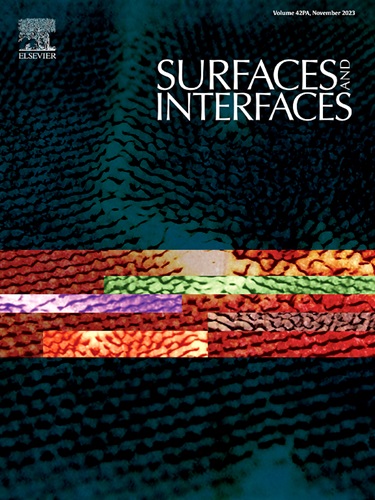Effect of pH on long-term corrosion protection of Zn doped MgAl-LDHs coatings by in situ growth on 5052 aluminum alloy
IF 5.7
2区 材料科学
Q2 CHEMISTRY, PHYSICAL
引用次数: 0
Abstract
In the present investigation, a hydrothermal method was successfully employed to in situ synthesize ZnMgAl layered double hydroxide (LDHs) coatings directly on the surface of 5052 aluminum alloy. The doping of Zn in the layered structure aims to further improve the corrosion resistance of MgAl-LDHs coatings. The effects of pH values (8, 8.5, 9, 9.5, and 10) on the microstructure and corrosion resistance of the fabricated LDHs coatings were investigated in this research using XRD, SEM, EDS, FTIR, XPS, electrochemical and immersion tests. The results revealed that the ZnMgAl-LDHs coatings had distinct hydrotalcite diffraction peaks and exhibited a typical hydrotalcite coating morphology. In comparison to the MgAl-LDHs coatings, the Zn-doped ZnMgAl-LDHs coatings were found to be more homogeneous and dense in structure. Notably, The ZnMgAl-LDHs coatings prepared at a pH of 8.5 exhibited the best corrosion resistance and were superior to the MgAl-LDHs coatings according to the electrochemical test results. In addition, the corrosion resistance of the ZnMgAl-LDHs coatings remained remarkably stable, with minimal degradation observed after a prolonged immersion period of 60 days in a 3.5 wt.% NaCl solution, thereby underscoring their long-term protective efficacy. The addition of Zn was conclusively identified as a pivotal factor in enhancing the corrosion resistance of the MgAl-LDHs coating, and the corrosion protection mechanism was also discussed in detail.

pH 值对 5052 铝合金上原位生长的掺锌 MgAl-LDHs 涂层长期腐蚀保护的影响
本文章由计算机程序翻译,如有差异,请以英文原文为准。
求助全文
约1分钟内获得全文
求助全文
来源期刊

Surfaces and Interfaces
Chemistry-General Chemistry
CiteScore
8.50
自引率
6.50%
发文量
753
审稿时长
35 days
期刊介绍:
The aim of the journal is to provide a respectful outlet for ''sound science'' papers in all research areas on surfaces and interfaces. We define sound science papers as papers that describe new and well-executed research, but that do not necessarily provide brand new insights or are merely a description of research results.
Surfaces and Interfaces publishes research papers in all fields of surface science which may not always find the right home on first submission to our Elsevier sister journals (Applied Surface, Surface and Coatings Technology, Thin Solid Films)
 求助内容:
求助内容: 应助结果提醒方式:
应助结果提醒方式:


